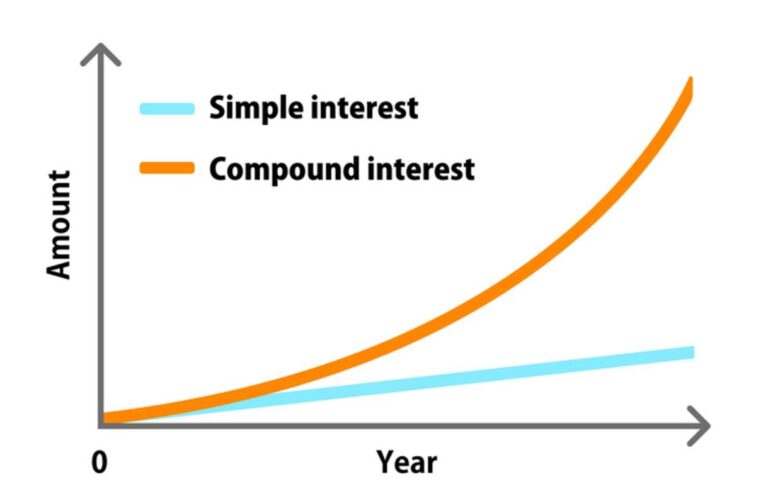Simple interest vs Compound interest: Differences and Definitions

Simple interest and compound interest are two important concepts in finance that are used to calculate the returns on investments. While both forms of interest involve earning money on an initial principal amount, they differ in the way that they are calculated and applied.
Simple interest is a straightforward calculation based on the principal amount, the interest rate, and the length of time the money is invested. Compound interest, on the other hand, involves calculating interest not only on the principal but also on the accumulated interest from previous periods.
What is simple interest?
Simple interest is a type of interest that is calculated based on the principal amount of an investment, the interest rate, and the length of time the money is invested. It is called “simple” because the interest calculation is straightforward and does not take into account any accumulated interest and does not take into account any accumulated interest from previous periods.
How simple interest is calculated: To calculate simple interest, you need to know the principal amount, the interest rate, and the length of time the money is invested.
Formula for calculating simple interest
The formula for calculating simple interest is interest = principal x rate x time.
For example, if you invested #1000
at a 5% annual interest rate for 2 years, the simple interest would be #1000 x 5 x 2 = #100.
What is compound interest?
Compound interest is a type of interest that is calculated not only on the principal amount of an investment but also on the accumulated interest from previous periods.
This means that the interest earned in each period is added to the principal, and the new, higher principal is used to calculate the interest in the next period. This process is repeated over time, resulting in exponential growth of the investment.
Formula for calculating compound interest
How compound interest is calculated: The formula for calculating compound interest is slightly more complex than the formula for calculating simple interest. To calculate compound interest, you need to know the principal amount, the interest rate, and the number of compounding periods per year.
The formula for calculating compound interest is compound interest = principal x (1 + rate/n)^(nt) – principal. For example, if you invested $1000 at a 5% annual interest rate with quarterly compounding for 2 years, the compound interest would be $1000 x (1 + 0.05/4)^(42) – $1000 = $110.79.
Advantages of simple interest
- Simple interest is easy to understand and calculate, making it suitable for those who are new to the concept of interest.
- Simple interest charges a fixed rate of interest on the principal amount, making it predictable and transparent.
Disadvantages of simple interest
- Simple interest does not take into account the time value of money, which means that it does not offer as much return as compound interest over a longer period.
- Simple interest is not as beneficial for the borrower as it does not reduce the principal amount over time.
Advantages of compound interest
- Compound interest takes into account the time value of money, which means that it offers a higher return than simple interest over a longer period.
- Compound interest can be a good option for long-term investments as it can help grow wealth over time.
- Compound interest can help reduce the principal amount over time, making it more beneficial for the borrower.
Disadvantages of compound interest
- Compound interest can be difficult to understand and calculate, making it less suitable for those who are new to the concept of interest.
- Compound interest charges interest on both the principal amount and the accumulated interest, which can make it less transparent and more difficult to predict.
Difference between simple interest and compound interest
Simple interest and compound interest are two different methods of calculating the interest on a loan or an investment. Understanding the difference between these two methods can be important for borrowers and investors, as it can affect the total cost of a loan or the return on investment.
- Simple interest is calculated as a percentage of the principal amount only. This means that the borrower or investor will receive the same amount of interest every year, regardless of the length of the loan or the performance of the investment. The formula for calculating simple interest is Principal x Interest rate x Time = Interest.
- Compound interest is calculated on both the principal amount and the accumulated interest of a loan or investment. This means that the interest earned in one period is added to the principal, and the new total is used to calculate the interest for the next period. This process continues, with the interest accumulating over time. The formula for calculating compound interest is Principal x (1 + Interest rate)^Time = Total amount.
- Simple interest is generally easier to understand and calculate than compound interest. However, it can result in a lower total return for the borrower or investor, particularly over longer periods.
- Borrowers who choose a loan with simple interest may pay less in total, as the interest is calculated on the principal amount only. However, they may also have to pay a higher interest rate, as lenders may compensate for the lower total interest by charging a higher rate.
- Investors who choose an investment with compound interest may receive a higher return, as the interest accumulates over time. However, they may also be taking on more risk, as the value of their investment may fluctuate more over time.
The choice between simple and compound interest will depend on the specific needs and goals of the borrower or investor. It is important for borrowers and investors to carefully consider the terms of a loan or investment, including the type of interest being charged, to make an informed decision that aligns with their financial goals.
Conclusion
Simple interest and compound interest are two different methods of calculating the interest on a loan or investment. Simple interest is a straightforward way of calculating interest, while compound interest is a more complex method that can result in higher returns over time.
Understanding the difference between simple and compound interest can help borrowers and investors make more informed decisions about their financial future.
So, which is the best overall, compound interest or simple interest? The best option depends on the actual occurrence or event that is to be accomplished.
Don't miss a thing. Follow us on Telegram and Follow us on WhatsApp. If you love videos then also Subscribe to our YouTube Channel. We are on Twitter as MakeMoneyDotNG.





